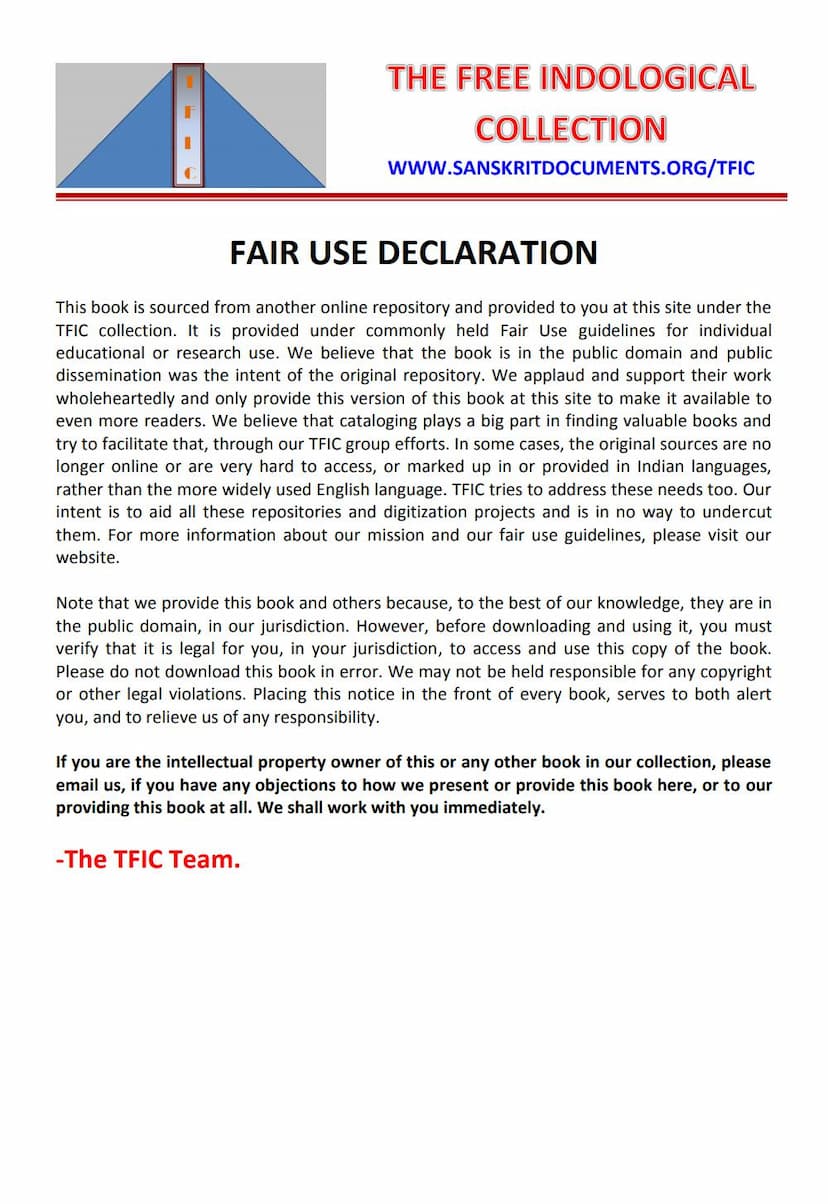Jain Itihas Ki Purva Pithika Aur Hamara Abhyutthana
Added to library: September 2, 2025

Summary
Here's a comprehensive summary of the provided Jain text, "Jain Itihas ki Purva pithika aur Hamara Abhyutthana" by Hiralal Jain, based on the text snippets:
This book, "Jain Itihas ki Purva pithika aur Hamara Abhyutthana" (Preliminary Introduction to Jain History and Our Renaissance), authored by Prof. Hiralal Jain and published in 1939, aims to explore the historical context and significance of Jainism. The preface acknowledges the work of various scholars in advancing Indian history and emphasizes the need to bolster historical understanding within Jain literature.
Key Themes and Arguments:
-
Authenticity and Interpretation of Jain Puranas:
- The book addresses the skepticism surrounding Jain Puranas, particularly regarding their vast time scales, exaggerated physical attributes and lifespans of ancient beings, and the cyclical nature of existence (Bhogabhumi and Karmabhumi).
- Jain Puranas mention time spans in "Palyas" and "Sagaras," which are astronomical. The author argues that with modern scientific understanding of the vastness of time and the continuous discovery of older human civilizations, these measurements are not necessarily impossible or unbelievable.
- The concept of longer lifespans and larger body sizes is supported by findings in paleontology, where fossils of giant ancient creatures have been discovered, suggesting a gradual reduction in size over time. This principle is applied to ancient humans as well, making the Puranic descriptions more plausible in a relative historical context.
- The transformation from a "Bhogabhumi" (period of effortless sustenance) to a "Karmabhumi" (period of labor and exertion) is presented not as unnatural but as a logical progression of civilization, akin to the concept of a "Golden Age" in other traditions.
-
The Historical Framework of Jainism:
- The author asserts that Jain history, accepted by mainstream historical scholarship, begins with Lord Mahavira and extends slightly before his time. However, for events predating Mahavira, the Jain Puranas are the primary source.
- The book highlights the continuity of Jain tradition through the "Kula-kars" (progenitors of society) and "Tirthankaras" (spiritual leaders). Rishabhadeva, the first Tirthankara, is presented as a significant figure who established Dharma, with his influence also recognized in Hindu Puranas. The invention of the "Brahmi script" (the precursor to the modern Nagari script) by Rishabhadeva for his daughter Brahmi is mentioned, connecting Jain tradition to a fundamental element of Indian literacy.
- The historical validation of later Tirthankaras like Neminatha and especially Parshvanatha is noted, with Mahavira's era being a crucial anchor for scientific historical research. The author expresses hope that further research will illuminate the timelines of other Tirthankaras as well.
- The Jain geographical descriptions, such as the division of Bharatavarsha and the origin of the Ganga and Indus rivers from the Himavat mountains, are found to be broadly consistent with modern geographical knowledge.
-
The Importance of History and Historical Research:
- The book strongly advocates for the significance of history in national and individual life, stating that a nation without its history lacks vitality, self-respect, and hope.
- It underscores the need to enrich Jain literature with historical accounts and correct prevailing misconceptions.
- The author praises the contributions of various scholars (like Rai Bahadur Gaurishankar Ojha, Kashi Prasad Jaiswal, Chandradhar Guleri, Rahul Sankrityayan, and Jayachandra Vidyalankar) who have significantly advanced the study of Indian history through their research in epigraphy, linguistics, archaeology, and socio-political history.
- The text laments the limited focus on the history of science, arts, and language within Hindi literature, and the need for more detailed regional and period-specific historical writings.
- The author stresses the importance of preserving historical materials like manuscripts, records, and inscriptions, and advocates for the use of photography for accurate and accessible reproduction of ancient texts.
-
The Spread and Historical Evidence of Jainism:
- The book addresses the historical misconception that Jainism is a mere offshoot of Buddhism, a view prevalent in the 19th century. This misconception arose from superficial comparisons of basic principles and the limited availability of Jain historical evidence.
- The author points to significant archeological and epigraphical findings, such as the Hathigumpha inscription of Kharavela, which provide concrete evidence for the ancient origins and widespread influence of Jainism. This inscription, in particular, is highlighted for its importance in confirming Puranic records and establishing the antiquity of Jainism in Orissa.
- The significance of inscriptions from Shravanabelgola, which helped establish Chandragupta Maurya's Jain affiliation, is emphasized.
- The text details the historical presence of Jainism across various regions of India, including Uttar Pradesh (mentioning sacred cities like Ayodhya, Varanasi, Hastinapur), Maharashtra, and South India (Tamil Nadu, Deccan). It notes how Jainism flourished and was patronized by various dynasties, even when its adherents became fewer in later periods.
- The book also discusses the linguistic aspect, highlighting the importance of Jain literature in Prakrit languages and the need to promote the study of these languages to understand Jain history and philosophy accurately.
- The example of the Tamil text "Kural" is discussed, with the author presenting arguments and scholarly opinions suggesting its authorship by a Jain Acharya, Elacharyar (possibly Kundakundacharya), underscoring the diffusion of Jain thought and literature across different regions.
In essence, "Jain Itihas ki Purva pithika aur Hamara Abhyutthana" serves as a foundational text that seeks to reconcile traditional Jain narratives with emerging historical and archeological evidence. It champions the importance of rigorous historical research for understanding Jainism's ancient roots, its extensive historical influence, and its philosophical depth, aiming to correct past misconceptions and foster a renewed appreciation for its rich heritage.